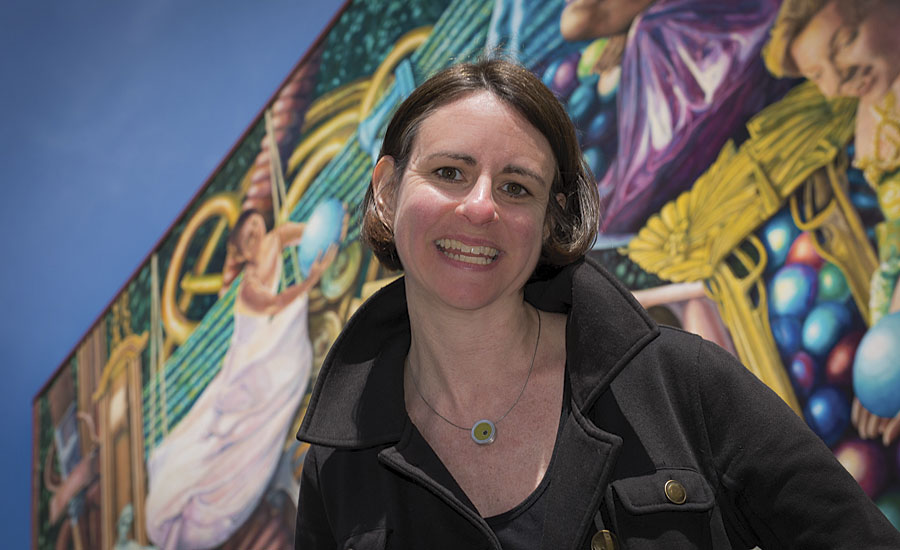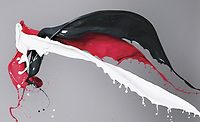The Artsy Side of Coatings Science
Dow Scientist Leverages Chemistry to Fuel Breakthroughs in Art Conservation

Melinda Keefe
When Melinda Keefe changed her major from art to chemistry during her freshman year of college, she could not have imagined the high-profile way these two passions of hers would combine in the decades to come. Eighteen years after earning her Bachelor of Science degree in chemistry from Penn State University and 14 years after completing her doctorate in inorganic chemistry at Northwestern University, Keefe is a recognized art conservation scientist. Her job at the Dow Chemical Company, where she began working in 2001, has helped lead her there.
Improving Paint for Dow
Keefe is a senior research and development manager in the Architectural Coatings division of Dow Coating Materials. Her work focuses on design and testing of paint formulations - no surprise, considering her love of art.
“My research has been focused primarily in the synthesis and testing of new binders and plastic pigments for use in paper coatings and architectural coatings, including high-throughput research for waterborne coatings,” Keefe explained.
Keefe was part of the Dow team that developed EVOQUE™ pre-composite polymer technology, which launched in 2011 and was awarded the US EPA 2013 Presidential Green Chemistry Award for its industrial contributions to green science.
Keefe also works on paint trials in outdoor exposure, trials of topcoat applications and other paint testing at Dow’s global “paint farms,” in which more than 100,000 formulations face the elements on upwards of 40,000 testing panels.
Discovering Art Conservation Science
It’s easy to see how the art world could use an understanding of paint as in-depth as Keefe’s. In 2007, she decided to move toward merging her two passions even more. She led a discussion at Dow about inorganic and organic pigments used in fine art and developed a professional relationship with conservation expert Gregory Smith, then the Andrew W. Mellon Assistant Professor of Conservation Science at Buffalo State College.
Smith, who now works at the Indianapolis Museum of Art, helped Keefe learn the basics of art conservation science and connect with important players in the space. Keefe received a two-year AXA Art fellowship offer to further research into the effects of conservation methods such as surface cleaning on the properties of acrylic emulsion paints from the Tate Gallery in London. As an alternative, Keefe decided to suggest a research collaboration between Dow, The Getty Conservation Institute (GCI) and Tate, that would allow her to work with the art conservation community while maintaining her position at Dow. Today, Dow, GCI and the Tate all work together to develop and spread the word about new methods for cleaning, conserving and restoring precious works of art.
The art conservation field, like most fields, has an abundance of research opportunities. Dow strives to identify critical technical challenges in the field with its collaborative partners that it is uniquely positioned to solve. For example, Dow products are used in many forms of contemporary art, including acrylic paintings, which provides the company an in depth understanding of these materials. Many Dow products are also used by art conservators for restoration -for example Dow’s PARALOID™ resins have been a standard material used for varnishing, consolidation and adhesion for decades.
With Keefe’s initial research with the Tate and GCI to customize wet cleaning systems for water-sensitive art complete, the team is now focused on bringing this research into practice through workshops, conferences and publications. Keefe and others involved in the collaboration are now working to improve clear protective topcoats for artwork through the use of solvents and solvent blends that provide more robust polymeric films based on the PARALOID resins. The solvents being explored are also safer than common aromatic solvents such as xylene, commonly used for these types of applications today. These protective coatings serve a variety of functions including varnishes for paintings and protective topcoats for bronze sculpture.
In 2013, Keefe had the opportunity to contribute to the restoration treatment of a 1958 piece of modern art, “Black on Maroon,” which was vandalized with graffiti ink in 2012.
Keefe and fellow Dow scientist, Felipe Donate, worked with the museum to identify and analyze solvent candidates to remove the graffiti ink scrawled over the Mark Rothko painting, without damaging the artwork. Aided by the information the chemists provided, experts at Tate identified the right combination of chemicals - benzyl alcohol and ethyl lactate - to remove the graffiti. Apart from enabling the return of the painting to display at Tate Modern, one of the highlights of this project was the highly collaborative effort of many people and institutions in support of this unique conservation treatment. This collaborative research also included a full compositional analysis of the graffiti ink including analytical support from Tate, Dow and JAAP Enterprise. This analytical take-apart illuminated how different and complex this graffiti ink is compared to traditional inks - speaking to the true complexity of this conservation treatment. These efforts will better enable future treatments tasked with removing similar markings. The results from the analytical characterization will be published soon in the technical and conservation literature.
Accolades
Her foray into art conservation science has helped to earn Keefe the number 21 spot in Fortune magazine’s “Heroes of the 500,” and a 2015 Women Chemists Committee Rising Star Award from the American Chemical Society. She also has co-authored many publications and made numerous presentations on the chemistry of art conservation.
But the work seems like something she’d do even if it didn’t bring her recognition.
“It’s about preserving our heritage. We’re using science to make better choices for conservation,” Keefe said. “These works of art will degrade over time. We’re trying to slow that rate and preserve them for future generations.”
Through clever collaborations and a commitment to her personal passions, Keefe’s work has demonstrated that sound science can lead to truly novel solutions -often in the most unexpected of places.
Looking for a reprint of this article?
From high-res PDFs to custom plaques, order your copy today!








